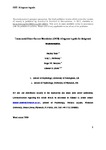Transcranial Direct Current Stimulation (tDCS): A Beginner's Guide for Design and Implementation
| dc.contributor.author | Thair, H | |
| dc.contributor.author | Holloway, A | |
| dc.contributor.author | Newport, R | |
| dc.contributor.author | Smith, Alastair | |
| dc.date.accessioned | 2017-12-06T11:00:27Z | |
| dc.date.available | 2017-12-06T11:00:27Z | |
| dc.date.issued | 2017-11-22 | |
| dc.identifier.issn | 1662-453X | |
| dc.identifier.issn | 1662-453X | |
| dc.identifier.other | ARTN 641 | |
| dc.identifier.uri | http://hdl.handle.net/10026.1/10374 | |
| dc.description.abstract |
Transcranial direct current stimulation (tDCS) is a popular brain stimulation method that is used to modulate cortical excitability, producing facilitatory or inhibitory effects upon a variety of behaviors. There is, however, a current lack of consensus between studies, with many results suggesting that polarity-specific effects are difficult to obtain. This article explores some of these differences and highlights the experimental parameters that may underlie their occurrence. We provide a general, practical snapshot of tDCS methodology, including what it is used for, how to use it, and considerations for designing an effective and safe experiment. Our aim is to equip researchers who are new to tDCS with the essential knowledge so that they can make informed and well-rounded decisions when designing and running successful experiments. By summarizing the varied approaches, stimulation parameters, and outcomes, this article should help inform future tDCS research in a variety of fields. | |
| dc.format.extent | 641- | |
| dc.format.medium | Electronic-eCollection | |
| dc.language | eng | |
| dc.language.iso | en | |
| dc.publisher | Frontiers Media | |
| dc.subject | transcranial direct current stimulation | |
| dc.subject | brain stimulation | |
| dc.subject | protocol | |
| dc.subject | cortical modulation | |
| dc.subject | anodal | |
| dc.subject | cathodal | |
| dc.title | Transcranial Direct Current Stimulation (tDCS): A Beginner's Guide for Design and Implementation | |
| dc.type | journal-article | |
| dc.type | Journal Article | |
| plymouth.author-url | https://www.webofscience.com/api/gateway?GWVersion=2&SrcApp=PARTNER_APP&SrcAuth=LinksAMR&KeyUT=WOS:000415995400001&DestLinkType=FullRecord&DestApp=ALL_WOS&UsrCustomerID=11bb513d99f797142bcfeffcc58ea008 | |
| plymouth.issue | NOV | |
| plymouth.volume | 11 | |
| plymouth.publication-status | Published online | |
| plymouth.journal | Frontiers in Neuroscience | |
| dc.identifier.doi | 10.3389/fnins.2017.00641 | |
| plymouth.organisational-group | /Plymouth | |
| plymouth.organisational-group | /Plymouth/Faculty of Health | |
| plymouth.organisational-group | /Plymouth/Faculty of Health/School of Psychology | |
| plymouth.organisational-group | /Plymouth/REF 2021 Researchers by UoA | |
| plymouth.organisational-group | /Plymouth/REF 2021 Researchers by UoA/UoA04 Psychology, Psychiatry and Neuroscience | |
| plymouth.organisational-group | /Plymouth/Users by role | |
| plymouth.organisational-group | /Plymouth/Users by role/Academics | |
| plymouth.organisational-group | /Plymouth/Users by role/Researchers in ResearchFish submission | |
| dc.publisher.place | Switzerland | |
| dcterms.dateAccepted | 2017-11-06 | |
| dc.identifier.eissn | 1662-453X | |
| dc.rights.embargoperiod | Not known | |
| rioxxterms.versionofrecord | 10.3389/fnins.2017.00641 | |
| rioxxterms.licenseref.uri | http://www.rioxx.net/licenses/all-rights-reserved | |
| rioxxterms.licenseref.startdate | 2017-11-22 | |
| rioxxterms.type | Journal Article/Review |


